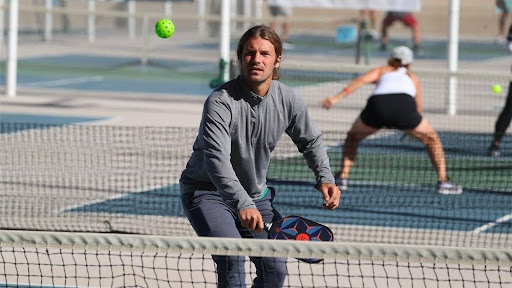In the thrilling world of pickleball, mastering the game is a journey filled with excitement, strategy, and, inevitably, a few missteps along the way. Whether you’re a seasoned player or just picking up a paddle for the first time, steering clear of common pickleball mistakes is key to elevating your game.
In this article, we’ll dive into “The Most Common Pickleball Mistakes and How to Avoid Them,” providing valuable insights and practical tips to keep you one step ahead on the court. Let’s uncover the secrets to a more polished pickleball performance!

Most Common Pickleball Mistakes and How to Avoid Them
Pickleball is a relatively simple game, but it also requires strategy, skill, and practice. Many beginners and even intermediate players make some common mistakes that can cost them points, games, or matches. Here are some of the most common pickleball mistakes and how to avoid them.
Mistake #1: Standing in No Man’s Land and How to Move to the Kitchen Line
No man’s land is the area between the baseline and the non-volley zone line, also known as the kitchen line. This is a dangerous place to stand in pickleball, because you are vulnerable to both deep and short shots from your opponents. You are also too far away to hit effective volleys or dinks, and you have less time to react to the ball.
The best way to avoid standing in no man’s land is to move to the kitchen line as soon as possible after hitting your serve or return of serve. The kitchen line is the ideal position to control the rally, as you can hit volleys, dinks, or drop shots to keep your opponents off balance. You can also cover more angles and reduce the chances of hitting the net or going out of bounds.
To move to the kitchen line, you need to have good footwork, anticipation, and timing. You should use small, quick steps to move forward, while keeping your paddle up and ready. You should also watch the ball and your opponents, and adjust your position accordingly.
You should not rush to the kitchen line, but rather move in sync with the ball. If the ball is too low or too fast, you may need to stay back and hit a groundstroke instead of a volley.
Mistake #2: Neglecting the Dink Shot and How to Master It
The dink shot is one of the most important and effective shots in pickleball, but it is also one of the most neglected and underused by many players. The dink shot is a soft, short, and low shot that lands in the opponent’s kitchen, forcing them to hit up and giving you a chance to hit down.
The best way to avoid neglecting the dink shot is to master it and use it frequently, especially when you are at the kitchen line. The dink shot can help you win rallies, as you can create openings, exploit weaknesses, or induce errors from your opponents.
To master the dink shot, you need to have good touch, control, and patience. You should use a continental or modified continental grip, which allows you to hit both forehand and backhand dinks with ease. You should also use a short and compact swing, with minimal backswing and follow-through.
You should aim for the lowest part of the net, and hit the ball with a slight upward motion and a gentle push. You should also vary the direction and spin of your dinks, to make them harder to anticipate and return. You should also be patient and wait for the right moment to hit a winning shot, instead of forcing it or rushing it.
“Spend 30 minutes per practice session working specifically on dink placements, spins, and sequences. This will sharpen your touch and finesse around the kitchen, suggest Elvin A. Sears from BeBallPlayers.”
Mistake #3: Playing Too Tight and How to Relax and Swing Freely
Another common pickleball mistake is playing too tight, which means being tense, nervous, or anxious during the game. This can affect your performance, as you may lose your focus, make more errors, or miss opportunities.
The best way to avoid playing too tight is to relax and swing freely, which means being calm, confident, and fluid during the game. This can improve your performance, as you may have more fun, make better decisions, or hit more winners.
To relax and swing freely, you need to have good breathing, visualization, and positive self-talk. You should breathe deeply and rhythmically, to lower your heart rate and blood pressure, and to oxygenate your muscles and brain.
You should visualize yourself playing well, hitting your shots, and winning points, to boost your confidence and motivation. You should also talk to yourself positively, to reinforce your strengths, overcome your weaknesses, and cope with challenges.
Mistake #4: Hitting the Ball to Your Opponent’s Forehand and How to Target Their Backhand
One of the most common pickleball mistakes is hitting the ball to your opponent’s forehand, which is usually their stronger and more comfortable side. This gives them an advantage, as they can hit more powerful and accurate shots, and put you on the defensive.
The best way to avoid hitting the ball to your opponent’s forehand is to target their backhand, which is usually their weaker and more awkward side. This forces them to hit more difficult and less confident shots, and gives you an opportunity to attack or counterattack.
To target your opponent’s backhand, you need to have good accuracy, placement, and spin. You should aim for the corners or the middle of the court, depending on the situation and your opponent’s position.
You should also use different types of spin, such as topspin, backspin, or sidespin, to make the ball bounce unpredictably and harder to return. You should also vary the speed and depth of your shots, to keep your opponent guessing and off rhythm.
Mistake #5: Having a Poor Serve Technique and How to Improve It
The serve is the first and most important shot in pickleball, as it starts the rally and sets the tone for the point. However, many players have a poor serve technique, which can result in weak, inaccurate, or faulted serves.
The best way to avoid having a poor serve technique is to improve it and practice it regularly. A good serve technique can help you gain an edge over your opponents, as you can hit more powerful, consistent, or deceptive serves.
To improve your serve technique, you need to have good stance, grip, motion, and contact. You should stand with your feet shoulder-width apart, and your front foot slightly ahead of your back foot. You should use a continental or modified continental grip, which allows you to hit different types of serves with ease.
You should also use a smooth and fluid motion, with a moderate backswing and follow-through. You should hit the ball at the highest point of your reach, and with a slight downward motion and a firm snap.
You should also aim for the corners or the middle of the court, depending on the situation and your opponent’s position. You should also use different types of spin, such as topspin, backspin, or sidespin, to make the ball bounce unpredictably and harder to return.
Mistake #6: Failing to Communicate with Your Partner and How to Collaborate Effectively
Pickleball is a team sport, where you play with a partner against another pair of opponents. Therefore, communication is key to success, as it helps you coordinate your moves, strategies, and tactics. However, many players fail to communicate with their partner, which can result in confusion, frustration, or mistakes.
The best way to avoid failing to communicate with your partner is to collaborate effectively and talk to them frequently. Effective collaboration can help you win points, games, or matches, as you can work as a unit, complement each other, and support each other.
To collaborate effectively, you need to have good verbal and non-verbal communication, as well as trust and respect. You should use clear and concise words, such as “mine”, “yours”, “switch”, or “poach”, to indicate who will take the ball, or what action to take.
You should also use eye contact, gestures, or signals, to convey your intentions, plans, or feedback. You should also trust and respect your partner, by listening to them, following their lead, or backing them up.
Mistake #7: Staying in the Kitchen and How to Avoid Kitchen Faults
The kitchen, or the non-volley zone, is the area within 7 feet of the net, where you are not allowed to hit the ball in the air, or step into while hitting the ball. The kitchen is a strategic area, where you can hit dinks, drop shots, or volleys, to keep your opponents at bay. However, many players stay in the kitchen too long, or step into the kitchen accidentally, which can result in kitchen faults.
The best way to avoid staying in the kitchen and committing kitchen faults is to be aware of the rules and your position. A kitchen fault occurs when you or your paddle touch the kitchen while hitting the ball in the air, or when you step into the kitchen before the ball bounces. A kitchen fault results in a loss of point or serve.
To be aware of the rules and your position, you need to have good vision, balance, and footwork. You should watch the ball and your opponents, and know where the kitchen line is at all times.
You should also keep your balance and your paddle in front of you, and avoid leaning or reaching into the kitchen. You should also use small, quick steps to move in and out of the kitchen, and avoid jumping or sliding.
Well, That’s a Wrap
As we wrap up our exploration of the most common pickleball mistakes, remember that every misstep is an opportunity to refine your skills and enhance your game. By avoiding these pitfalls and implementing the tips provided, you’re well on your way to becoming a more formidable pickleball player.
So, hit the courts with confidence, stay mindful of these lessons, and let your improved game speak for itself. Here’s to error-free rallies and countless victorious matches on your pickleball journey!









